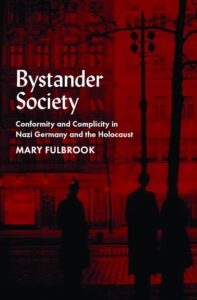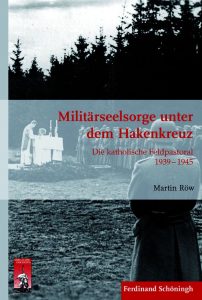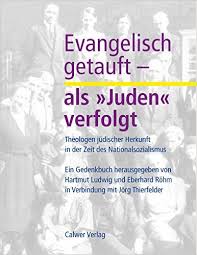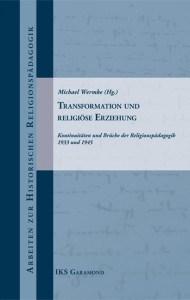Contemporary Church History Quarterly
Volume 31, Number 2 (Summer 2025)
Review of Mary Fulbrook. Bystander Society: Conformity and Complicity in Nazi Germany and the Holocaust. (Oxford: Oxford University Press, 2023), pp. 488
By Blake McKinney, Texas Baptist College
Raul Hilberg famously employed a tripartite schema in his Perpetrators Victims Bystanders: The Jewish Catastrophe, 1933-1945. Subsequent works have often divided German society in the Third Reich along these lines. Some have lumped most of the population in the perpetrator category. Others have portrayed German society as a neat bell curve in which perpetrators and victims make up the extremes and the vast majority fit within the bell as bystanders. While categorizations have heuristic value, simple categorical divisions fail to adequately describe the complexity of human activity and change over time. In Bystander Society: Conformity and Complicity in Nazi Germany and the Holocaust, Mary Fulbrook probes the complexity of the concept of “bystanders”— a group she describes as “the muddled middle.”
 Mary Fulbrook is Professor of German History at University College London. She is a familiar and respected contributor to scholarship on Nazi Germany and the Holocaust. In this work she avoids teleological interpretations of events and rejects simplistic categorizations. She endeavors to tell the story of German bystanders “from the inside out” through “selected accounts of personal experiences” (16). She tells the stories of individuals. In so doing, she humanizes history. Victims and bystanders had names. They had stories. They were not a grouping of data points on a chart. Fulbrook’s subjects are profoundly human, and their complex stories challenge facile characterizations of society in Nazi Germany. Fulbrook’s primary sources for Part I are autobiographical essays from 1939 written on the theme “My life in Germany before and after January 30, 1933.” These essays give a broad range of everyday experiences before such memories were shaped by knowledge of the horrors of the Holocaust. Likewise, in Part II she employs a variety of firsthand accounts and memoirs to tell stories from the ground level. Fulbrook argues well for the value and limitations of her source base in her introduction.
Mary Fulbrook is Professor of German History at University College London. She is a familiar and respected contributor to scholarship on Nazi Germany and the Holocaust. In this work she avoids teleological interpretations of events and rejects simplistic categorizations. She endeavors to tell the story of German bystanders “from the inside out” through “selected accounts of personal experiences” (16). She tells the stories of individuals. In so doing, she humanizes history. Victims and bystanders had names. They had stories. They were not a grouping of data points on a chart. Fulbrook’s subjects are profoundly human, and their complex stories challenge facile characterizations of society in Nazi Germany. Fulbrook’s primary sources for Part I are autobiographical essays from 1939 written on the theme “My life in Germany before and after January 30, 1933.” These essays give a broad range of everyday experiences before such memories were shaped by knowledge of the horrors of the Holocaust. Likewise, in Part II she employs a variety of firsthand accounts and memoirs to tell stories from the ground level. Fulbrook argues well for the value and limitations of her source base in her introduction.
Fulbrook divides her analysis into two parts. Part I, “The Slippery Slope: Social Segregation in Nazi Germany,” analyzes German society from the First World War until the beginning of Hitler’s territorial expansions. Periodization matters in historical argumentation, and Fulbrook tells a fuller story of German society by beginning her narrative well before Hitler’s rise to the chancellorship. She gives a rich account of German society and the experience of German Jews before the racialization of the Nazi period. She demonstrates the shift from pre-1933, when “social class, gender, regional, family, or individual issues had been far more significant than religious affiliation or Jewish ancestry”, to the enforcement of (and voluntary conformity with) the dichotomy of “Aryan”/”non-Aryan” divisions in the first years of the Third Reich (27).
Three out of the five chapters in Part I detail societal changes before the Nuremberg Race Laws of 1935. Fulbrook demonstrates that, well before the Nuremberg Laws, “Germans were already learning and practising distinctions between ‘Aryans’ and ‘non-Aryans’ in everyday life, and with far-reaching consequences” (91). She asserts, “widespread acceptance and more or less willing enactment… was key to the broader impact of Nazi racism over time” (103). In account after account, Fulbrook illustrates the complexities of conformity and concern. Many victims of National Socialist racial policies recorded moments of kindness from their “Aryan” compatriots, but these were nearly always marked by fear and considerations of self-preservation. Fulbrook contends that this mixture of public conformity and private misgivings allowed non-Jewish Germans to enjoy “both the benefits of public conformity and the moral glow of private dissidence,” but “in the process, this pre-emptively conformist behaviour only served further to define and deepen the rifts that Nazi ideology introduced” (118). The implementation of the Nuremberg Race Laws in 1935 further solidified broad conformity with mandated racial discrimination. Part I demonstrates the shift from voluntary conformity to compulsory conformity to Nazi racial policies within Germany.
Part II – “The Expansion of Violence at Home and Abroad” – traces the broader and devastating reach of Nazi racial policies as the Nazi regime began to dominate its neighbors. Chapter six examines the spread of Nazi racial ideology among the German-speaking populations throughout Europe with particular attention on the Baltic states and Austria. Regarding Austria, Fulbrook concludes “the progression from conformity through compliance to complicity was massively accelerated” compared to the early years of Nazi Germany (193). Chapter seven highlights Kristallnacht as a definitive turning point for the “bystander society” in Germany. If non-Jewish Germans feared the potential violent response if they protested mistreatment of “non-Aryans” from 1933-1934, the unrestrained violence of November 9-10, 1938 demonstrated the danger of not conforming with state definitions of the Volksgemeinschaft. Fulbrook asserts, “In November 1938, it was neither ignorance nor indifference that shaped the polarization of popular responses, but perceptions of the relative risks versus potential benefits of different forms of action” (232). Simply put: Kristallnacht changed the math for those calculating the reasonableness of aiding their “non-Aryan” neighbors, diminishing the already small minority of those willing to not conform.
The next two chapters detail the horrific escalation of violence resulting in genocide. Chapters ten and eleven examine the category of “bystander” for Germans from 1941-1945. Chapter ten, “Inner Emigration and the Fiction of Ignorance,” demonstrates the widespread awareness of extreme violence against Jews committed in the East. Auschwitz often functions as a metonym for the Holocaust. Fulbrook explores how German “bystanders” employed this practice to claim ignorance: “The popular refrain ‘we knew nothing about it’ generally restricted the ‘it’ to a very narrow focus, such as the chambers of Auschwitz-Birkenau. The focus on ‘Auschwitz,’ or ‘gas chambers,’ effectively excluded the discrimination and persecution of the peacetime years, with which the majority of people had been forced to comply, in which many had more actively participated, and from which many had also benefitted” (311). Fulbrook covers a wide array of personal cases where non-Jewish Germans learned of the murderous atrocities against Jews. At this point in the regime’s power (and usage of violence), she acknowledges the great difficulty facing citizens who ran the risk of becoming victims of extreme violence if they expressed dissent, “yet remaining silent meant in effect condoning brutality and murder, even if this strategy was a form of ‘muddling through’ in existentially threatening times” (339).
Fulbrook concludes with an indictment of both German elites and the wider society, but with elites bearing the greater burden. She faults elites for not standing against Hitler at an early stage, which left members of the wider society in “an arena of repression and violence, in which it was easier to conform” (341). Fulbrook identifies gradual societal change rather than a driving ideology as the crucial feature of the creation of a “bystander society” that acquiesced to (and often benefitted from) the persecution of Jews. She argues that the greatest lesson is to “explore how very small changes in everyday life that seem anodyne or justifiable at the time can have catastrophic consequences within a matter of just a few years” (374). The pre-war Nazi years are more than the “Seizure of Power,” the Nuremberg Laws, and Kristallnacht. Fulbrook’s careful narration of everyday shifts and accommodations to Nazi racial policy in German society show the complexity of human agency and possible choices in the face of growing violence.
Mary Fulbrook’s account of German bystanders reflects both sympathy for the difficulty of choices made under the shadow of violence as well as grief that courage was the exception and not the rule. She reflects upon the emergence of a “bystander society” — “a society in which social relations and political conditions are such that most people would either not want or not dare to intervene on behalf of victims, and in which most people learned to look away” (381). With hindsight, one can see that the early years of the Nazi regime were the years in which dissidence would have proven most effective, yet in those early months and years when so many Germans expected National Socialism to be a passing fad, many opportunities were missed as people just muddled through. Fulbrook closes her book with a final charge that the best way to enact the cry of “never again” is to be aware enough to enact “earlier or more effective intervention. It is, then, vital that we extend our understanding of the historically contingent conditions for the production of a bystander society” (399). Mary Fulbrook’s Bystander Society enriches the scholarship on German society in the Third Reich and serves as a helpful reminder of the gradual developments that lead to nightmarish catastrophes.
While not directly addressing the scholarship of the modern German churches, this book will help inform future studies addressing the everyday experience of otherwise anonymous members of German society in the Nazi era. Scholars of the German churches will recognize the growth of state power in the mid-1930s that made dissidence far less probable or effective than it was in 1933. Fulbrook’s concept of the “muddled middle” may find particular resonance in studies of German Protestantism, which have often focused on the Confessing Church and Deutsche Christen minorities to the neglect of the majority.

 Röw’s intentions are to deliver a comprehensive structural and experiential history of Catholic military pastoral care in Germany, with a particular emphasis on providing a systematic study of chaplaincy (12). He has oriented himself solidly in the available historiography on the subject in both German and English and his archival research is impressively broad, gathering material from four archdiocesan archives (including Salzburg), eight diocesan archives (including one in Austria and one in the Netherlands), and several other state and private collections in Germany. His main source for primary documentation is the Archive of the Catholic Military Bishop, in Berlin, notably the Georg Werthmann collection. Until relatively recently, this rich compilation of chaplaincy-related material, produced by the man who served as second-in-command of the Catholic chaplaincy during the Second World War, was strikingly understudied; in the past four years, three books have appeared whose authors have extensively mined its records.
Röw’s intentions are to deliver a comprehensive structural and experiential history of Catholic military pastoral care in Germany, with a particular emphasis on providing a systematic study of chaplaincy (12). He has oriented himself solidly in the available historiography on the subject in both German and English and his archival research is impressively broad, gathering material from four archdiocesan archives (including Salzburg), eight diocesan archives (including one in Austria and one in the Netherlands), and several other state and private collections in Germany. His main source for primary documentation is the Archive of the Catholic Military Bishop, in Berlin, notably the Georg Werthmann collection. Until relatively recently, this rich compilation of chaplaincy-related material, produced by the man who served as second-in-command of the Catholic chaplaincy during the Second World War, was strikingly understudied; in the past four years, three books have appeared whose authors have extensively mined its records. Evangelisch getauft—als “Juden” verfolgt is not a comprehensive history of this topic; nonetheless it is a valuable contribution to the literature. As its subtitle indicates, it is primarily a Gedenkbuch with brief biographies of 180 German Protestants whose lives were changed by the racial laws and the responses of their church. The editors have cast a wide net. The individuals profiled here include not only theologians and members of the Christian clergy, but individuals who were barred from studying theology before 1945 and others who, barred from other professions, decided to study theology in exile. Also included are teachers of religious education, Christians in “mixed” marriages, Austrians who came under Nazi law after 1938, and even several individuals who were Deutsche Christen or members of the Nazi party. While most of those profiled were members of the German Evangelical Church, there are also several profiles of individuals from Methodist, Baptist, and other free churches.
Evangelisch getauft—als “Juden” verfolgt is not a comprehensive history of this topic; nonetheless it is a valuable contribution to the literature. As its subtitle indicates, it is primarily a Gedenkbuch with brief biographies of 180 German Protestants whose lives were changed by the racial laws and the responses of their church. The editors have cast a wide net. The individuals profiled here include not only theologians and members of the Christian clergy, but individuals who were barred from studying theology before 1945 and others who, barred from other professions, decided to study theology in exile. Also included are teachers of religious education, Christians in “mixed” marriages, Austrians who came under Nazi law after 1938, and even several individuals who were Deutsche Christen or members of the Nazi party. While most of those profiled were members of the German Evangelical Church, there are also several profiles of individuals from Methodist, Baptist, and other free churches. Two of the chapters are biographical studies of individual religious educators or professors at teacher training institutions. Thomas Martin Schneider’s “Die Umbrüche 1933 und 1945 und die Religionspädagogik” takes up the story of Georg Maus, a religion teacher at an Oberschule in Idar- Oberstein. Maus, who was associated with the Confessing Church, was accused of undermining the war effort because he failed to properly manage a class discussion of Jesus’ command to love one’s enemies. He received a two-year sentence and died while being transported to Dachau. Schneider contrasts Maus’ story with that of Reinhold Krause, also an educator, but most famous for his address to members of the German Christian Movement at the Berlin Sport Palace Rally in 1933. Schneider finds that Krause both appropriated and violated aspects of liberal Protestant thought. The cases of Maus and Krause, Schneider argues, call into question both the “conservative decadence model” that blames liberal Protestant theology for Nazi conceptions of Christianity and the “progress- optimistic model” that exonerates it of all charges. Theological orientations, including diverse political theologies in the twentieth century, cannot be judged apart from their historical contexts. Likewise, one should not reduce contemporary religious education to the narrow range of options that were present in the Third Reich, nor should one assume that those options will have the same value in all historical settings.
Two of the chapters are biographical studies of individual religious educators or professors at teacher training institutions. Thomas Martin Schneider’s “Die Umbrüche 1933 und 1945 und die Religionspädagogik” takes up the story of Georg Maus, a religion teacher at an Oberschule in Idar- Oberstein. Maus, who was associated with the Confessing Church, was accused of undermining the war effort because he failed to properly manage a class discussion of Jesus’ command to love one’s enemies. He received a two-year sentence and died while being transported to Dachau. Schneider contrasts Maus’ story with that of Reinhold Krause, also an educator, but most famous for his address to members of the German Christian Movement at the Berlin Sport Palace Rally in 1933. Schneider finds that Krause both appropriated and violated aspects of liberal Protestant thought. The cases of Maus and Krause, Schneider argues, call into question both the “conservative decadence model” that blames liberal Protestant theology for Nazi conceptions of Christianity and the “progress- optimistic model” that exonerates it of all charges. Theological orientations, including diverse political theologies in the twentieth century, cannot be judged apart from their historical contexts. Likewise, one should not reduce contemporary religious education to the narrow range of options that were present in the Third Reich, nor should one assume that those options will have the same value in all historical settings. Christopher Probst has written an insightful analysis of the ways in which Protestant reformer Martin Luther’s anti-Jewish writings were used by German Protestants during the Third Reich. Fundamental to Probst’s work is his consistent use of Gavin Langmuir’s distinction between non-rational anti-Judaism (antipathy rooted in theological differences or other symbolic language which stand apart from and not against rational thought) and irrational antisemitism (antagonism rooted in factually untrue and slanderous accusations against Jews). In contrast to the idea that pre-modern anti-Jewish thought was generally religious and therefore anti-Judaic while modern anti-Jewish thought is political or racial and therefore antisemitic, Probst sees both anti-Judaic and antisemitic elements in the language of Luther and the twentieth-century German theologians, church leaders, and pastors who invoked him (3-4, 6, 17-19). In light of this, Demonizing the Jews is a book about historical continuity.
Christopher Probst has written an insightful analysis of the ways in which Protestant reformer Martin Luther’s anti-Jewish writings were used by German Protestants during the Third Reich. Fundamental to Probst’s work is his consistent use of Gavin Langmuir’s distinction between non-rational anti-Judaism (antipathy rooted in theological differences or other symbolic language which stand apart from and not against rational thought) and irrational antisemitism (antagonism rooted in factually untrue and slanderous accusations against Jews). In contrast to the idea that pre-modern anti-Jewish thought was generally religious and therefore anti-Judaic while modern anti-Jewish thought is political or racial and therefore antisemitic, Probst sees both anti-Judaic and antisemitic elements in the language of Luther and the twentieth-century German theologians, church leaders, and pastors who invoked him (3-4, 6, 17-19). In light of this, Demonizing the Jews is a book about historical continuity.